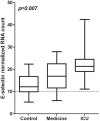Angiopoietin-2 as a marker of endothelial activation is a good predictor factor for intensive care unit admission of COVID-19 patients
- PMID: 32458111
- PMCID: PMC7250589
- DOI: 10.1007/s10456-020-09730-0
Angiopoietin-2 as a marker of endothelial activation is a good predictor factor for intensive care unit admission of COVID-19 patients
Abstract
Background: Coronavirus disease-2019 (COVID-19), a respiratory disease has been associated with ischemic complications, coagulation disorders, and an endotheliitis.
Objectives: To explore endothelial damage and activation-related biomarkers in COVID-19 patients with criteria of hospitalization for referral to intensive care unit (ICU) and/or respiratory worsening.
Methods: Analysis of endothelial and angiogenic soluble markers in plasma from patients at admission.
Results: Study enrolled 40 consecutive COVID-19 patients admitted to emergency department that fulfilled criteria for hospitalization. Half of them were admitted in conventional wards without any ICU transfer during hospitalization; whereas the 20 others were directly transferred to ICU. Patients transferred in ICU were more likely to have lymphopenia, decreased SpO2 and increased D-dimer, CRP and creatinine levels. In those patients, soluble E-selectin and angiopoietin-2 were significantly increased (p value at 0.009 and 0.003, respectively). Increase in SELE gene expression (gene coding for E-selectin protein) was confirmed in an independent cohort of 32 patients using a whole blood gene expression profile analysis. In plasma, we found a strong association between angiopoetin-2 and CRP, creatinine and D-dimers (with p value at 0.001, 0.001 and 0.003, respectively). ROC curve analysis identified an Angiopoietin-2 cut-off of 5000 pg/mL as the best predictor for ICU outcome (Se = 80.1%, Sp = 70%, PPV = 72.7%, NPV = 77%), further confirmed in multivariate analysis after adjustment for creatinine, CRP or D-dimers.
Conclusion: Angiopoietin-2 is a relevant predictive factor for ICU direct admission in COVID-19 patients. This result showing an endothelial activation reinforces the hypothesis of a COVID-19-associated microvascular dysfunction.
Keywords: Angiogenesis; Angiopoietin-2; Biomarker; COVID-19; E-selectin; Endothelial.
Conflict of interest statement
All authors declare nothing to disclose.
Figures




References
Publication types
MeSH terms
Substances
Grants and funding
LinkOut - more resources
Full Text Sources
Other Literature Sources
Molecular Biology Databases
Research Materials
Miscellaneous

